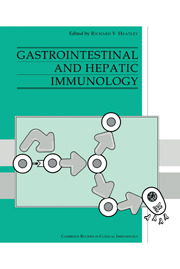Book contents
- Frontmatter
- Contents
- List of contributors
- Preface
- 1 Lymphoid cells and tissues of the gastrointestinal tract
- 2 Lymphocyte migration to the gut mucosa
- 3 Regulating factors affecting gut mucosal defence
- 4 Gastritis
- 5 The immunology of coeliac disease
- 6 Inflammatory bowel disease
- 7 Food intolerance and allergy
- 8 Gastrointestinal and liver involvement in primary immunodeficiency
- 9 Secondary immunodeficiency – the acquired immunodeficiency syndrome (AIDS)
- 10 Intestinal infections
- 11 Lymphomas
- 12 Small bowel transplantation
- 13 Clinical aspects of immunologically mediated intestinal diseases
- 14 Chronic active hepatitis
- 15 Primary biliary cirrhosis
- 16 Immunology and immunopathology of acute viral hepatitis
- 17 Immunology of liver transplantation
- 18 Clinical correlates with hepatic diseases
- Index
5 - The immunology of coeliac disease
Published online by Cambridge University Press: 03 February 2010
- Frontmatter
- Contents
- List of contributors
- Preface
- 1 Lymphoid cells and tissues of the gastrointestinal tract
- 2 Lymphocyte migration to the gut mucosa
- 3 Regulating factors affecting gut mucosal defence
- 4 Gastritis
- 5 The immunology of coeliac disease
- 6 Inflammatory bowel disease
- 7 Food intolerance and allergy
- 8 Gastrointestinal and liver involvement in primary immunodeficiency
- 9 Secondary immunodeficiency – the acquired immunodeficiency syndrome (AIDS)
- 10 Intestinal infections
- 11 Lymphomas
- 12 Small bowel transplantation
- 13 Clinical aspects of immunologically mediated intestinal diseases
- 14 Chronic active hepatitis
- 15 Primary biliary cirrhosis
- 16 Immunology and immunopathology of acute viral hepatitis
- 17 Immunology of liver transplantation
- 18 Clinical correlates with hepatic diseases
- Index
Summary
Introduction
Coeliac disease (CD) is a disease of the small intestine characterised by the development of villous atrophy, in response to ingestion of dietary proteins contained in wheat, barley and rye (Kelly et al., 1990). Villous atrophy, in turn, results in malabsorption of essential nutrients with the development of steatorrhea, weight loss and specific deficiency syndromes. Villous atrophy is associated with a cellular infiltrate comprising increased intra-epithelial lymphocytes, increased lamina propria lymphocytes and plasma cells (Anand et al., 1981; Fry et al., 1972; Ferguson,1987; Lancaster–Smith, Kumar & Dawson, 1975). Coeliac disease is tightly linked genetically to genes encoded in the major histocompatibility complex (MHC). In this respect it is similar to the auto-immune diseases of thyroid, pancreas and joints. However, since the precipitating agent is known, coeliac disease may serve as a useful model for auto-immune disease in the human if the interactions between genetic and environmental factors can be adequately defined. In this respect, an understanding of the genetic basis of coeliac disease is essential for an understanding of the immune hypotheses of the disease.
Genetic studies of coeliac disease
Coeliac disease shows a geographical predeliction, with a particularly high incidence in Northern Europe. There is a clear familial predisposition to the disease (Myllotte et al., 1974), but this does not follow classical Mendelian patterns, suggesting the possibility of multigenic and/or multifactorial aetiopathogenesis. Concordance in monozygotic twins occurs in approximately 75% of cases (Walker–Smith, 1973).
- Type
- Chapter
- Information
- Gastrointestinal and Hepatic Immunology , pp. 95 - 113Publisher: Cambridge University PressPrint publication year: 1994
- 2
- Cited by

